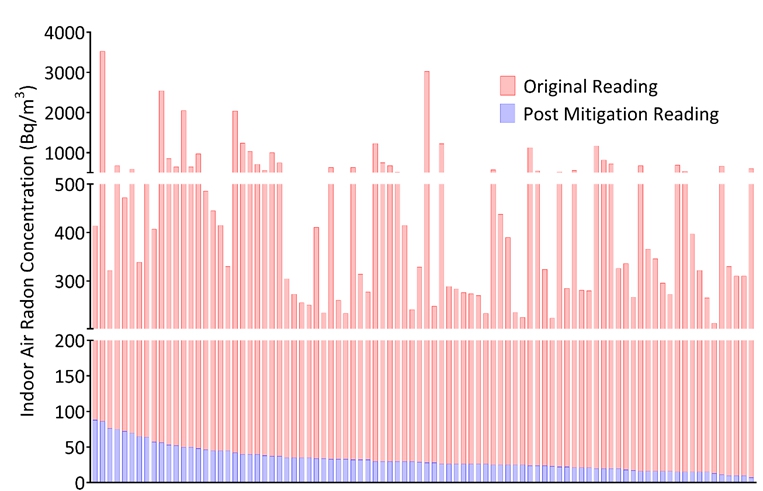Blog Summary:
- Radon gas inhalation is a significant health risk to Canadians, but many people in Canada don’t know what it is, or why testing matters.
- Testing your home for radon is the only way to know whether it contains dangerous levels. If it does, you can easily and quickly fix the issue by having your home mitigated for radon by a C-NRPP certified radon reduction professional.
- Radon is a radioactive gas that causes lung cancer and can be found in all Canadian homes, with high levels possible anywhere in the country. You can purchase a Health Canada recommended radon test kit at cost through The Evict Radon National Study, a research ethics board-approved, non profit cancer prevention project that involves researchers from across Canada.
Radon can pose a significant threat to the health of people throughout Canada by increasing lifetime risks of lung cancer, but many Canadians don’t fully understand its risks. In fact, only 34% of Canadian households can correctly identify what radon is, and only 6% of households report having tested for it in the past.
At The Evict Radon National Study, we aim to educate Canadians about radon, and encourage them to test their homes in an effort to make them safer and healthier. Here are 11 reasons why you should test your home for radon as soon as possible and arrange for radon mitigation by a C-NRPP certified professional if your home contains radon in significant amounts.
Want to know your home’s radon levels? Order a radon test kit here.
#1: Radon Causes Lung Cancer
After smoking, long term radon gas inhalation is the leading cause of lung cancer in Canada (and the leading cause among people who do not smoke tobacco). Here’s a breakdown of how inhaling radon leads to lung cancer:
- Radon releases a type of radiation known as particle radiation.
- Particle radiation causes damage to the DNA in cells within the lung tissue after radon is inhaled.
- The damage caused to our lungs is so extensive that the body’s natural repair processes are not able to deal with it effectively.
- This causes potentially harmful genetic mutations that increase risk of those lung cells becoming cancerous. The more radon we are exposed to, the more mutations occur and the higher our risk of lung cancer gets.
The International Agency for Research on Cancer (IARC), the global body that categorizes all cancer-causing exposures, classifies radon as “Category 1”, meaning that it is absolutely known to cause cancer in humans and animals. Other Category 1 compounds include things such as benzene, mustard gas, arsenic, and tobacco smoke.
#2: Radon Can Affect Anyone
You don’t have to be a heavy user of tobacco to get lung cancer from prolonged radon exposure. In fact, 1 in 5 people diagnosed with lung cancer in Canada today have never smoked tobacco, and overall, 1 in 6 deaths due to lung cancer are attributed to long term inhalation of high levels of radon gas.
A Canadian is diagnosed with a radon induced lung cancer every hour and 48 minutes. Radon testing can help you identify high levels of radon in your home and arrange to have them mitigated before it’s too late.
#3: Any Home in Canada Can Have High Radon Levels
While the average level of radon is somewhat higher in some regions of Canada than others, the Prairie, Northern, Atlantic, Central, and Pacific regions of Canada contain (respectively) the 2nd, 3rd, 4th, 7th and 16th highest average residential radon levels known in the world. Indeed, research shows that there is no such thing as a radon-free part of the country. Dangerous levels of radon can build up within homes anywhere in Canada.
See also: Radon Gas Map
#4: Canadians Face Higher than Average Radon and Lung Cancer Risks
In addition to Canada having the third-highest overall radon levels of any country in the world, we unfortunately also have much higher rates of lung cancer diagnosis and death relative to our low rates of tobacco smoking.
Compared to other cold-climate, highly developed nations with essentially identical smoking rates, such as Sweden, the rates of lung cancer are 163% greater in Canada. One reason for this is thought to be that radon levels in new Canadian homes are now 467% greater than their Swedish equivalents.

#5: Radon Can Build Up in Any Type of Home
Some people mistakenly believe that certain building types (including new homes) do not require radon testing. In reality, high radon levels are actually more common in newer homes in Canada, owing to multiple factors still being investigated by researchers.
While statistics show that certain types of homes may have higher average radon levels, it is essential to understand that high radon levels can exist in any kind of home. You should test your home for radon no matter how old your home is or how it is built.
See also: Types of Homes Likely to Contain High Radon
#6: Radon Cannot Be Detected by Taste or Smell
There are no “quick and dirty” or DIY ways to accurately measure radon levels, since radon is a tasteless, odorless, and invisible gas that is completely invisible to human senses, and leaves no obvious markings or signs within homes.
The only effective way to tell whether your home has dangerous radon levels is to use a Health Canada recommended long-term testing kit, which can be obtained by enrolling in The Evict Radon National Study at cost for anyone wishing to become a citizen scientist and radon test alongside cancer researchers.

#7: Radon Levels Can Vary Between Neighbouring Homes
Radon levels in the home next door are not a reliable indicator of radon levels in your home, as no two households are exactly alike (even if they have the same overall design). Not only can areas of soil in close proximity to each other have varying radon levels, but the construction, ventilation, and other features of the buildings on top of them can also be vastly different, affecting the amount of radon gas that builds up in each differently.
Even more importantly, the behaviour of the people living inside houses has been demonstrated to also have a strong effect on radon levels—and so even the same house occupied by two different groups of people can have different radon levels. The only way to be sure is to test the air your and your loved ones are breathing in any home you might ever live in.
#8: Radon Testing Is Easy
The long-term radon test kits used within The Evict Radon National Study do not require any external electrical power source, and can be left alone to function once you’ve placed them in your home for the entire duration of the test, which is for at minimum 3 months (90+ days) and up to a year.
To place the test device properly, all you need to do is choose a location in the lowest part of your home where you or someone else living in the property spends about 4 or more hours per day. A common place, for example, are bedside tables, as the air around there is something most of us spend many hours a day (or, more accurately, night) breathing. Find more information on obtaining, registering, and using your radon test kit here.
#9: Radon Testing Is Inexpensive
The radon testing kits used by Canadians participating in The Evict Radon National Study are provided at cost, and no member of the research term or any other group profit from this work. Our work and test costs are reviewed and ultimately approved by independent Research Ethics Boards who regulate our research activities.
The goals of the team leading The Evict Radon National Study are to ensure that as many Canadians as possible:
Can find scientifically accurate and demonstrated radon awareness information
Are enabled to test their homes for radon in a reliable manner
We also seek to help make Canada safer in the future by collecting up-to-date information about radon risks across the country and leveraging that data to find new ways to reduce radon exposure. To join this work and obtain a test kit via the national study, click here.
#10: All Canadian Homes Can Contain High Radon
Every home in Canada has some level of radon, and the important question is: how much? Testing is vital for knowing how much radon you might be exposed to in your life.
Health Canada recommends use of the “ALARA principle” when it comes to radon—this simply means everyone should try to get their radon levels to As Low As Reasonably Achievable. Further to this general idea, Health Canada also recommends that anyone with household radon levels that are at or over 200 Bq/m3 take steps to mitigate their radon levels as soon as possible. Find a C-NRPP certified radon mitigation professional in your area here.
#11: Radon Is a Solvable Problem
Radon is considered by many cancer specialists to be the most preventable source of the most prevalent and lethal type of cancer in Canada today (i.e., lung cancer). This is because, unlike tobacco, no-one is addicted to radon, and it is so easily and permanently removed from any indoor air environment where it is found to be high. This is a big problem with a good solution available now.
Although radon is our most common form of cancer causing agent exposure, it is the most preventable as well. The key thing is to know about radon, to know your personal exposure (by testing for it where you live, play, and work), and to take action to reduce that exposure if you find you are experiencing high levels. Radon mitigation carried out by a C-NRPP certified professional is highly effective at lowering radon levels in homes to below dangerous levels.

The chart above shows the radon readings in a sample of 100 Canadian residential homes that were tested for radon before and after a professional mitigation completed in the late 2010s. Data in red shows radon levels determined to be in the home by a long-term radon test, while the lines in blue show the radon levels after a C-NRPP certified radon mitigation system has been properly installed and activated.
The important takeaway message is that even homes with extremely high radon levels (many thousands of Bq/m3) were effectively reduced to less than 100 Bq/m3— levels that are not associated with any statistically elevated risk of lung cancer.
Take Action to Test Your Home for Radon Now
Knowing more about radon’s risks, the radon testing process, and what to do if your radon levels are high allows you to make informed decisions that protect your household. To learn more from an unbiased source, contact one of the experts in the Evict Radon National Study today.
